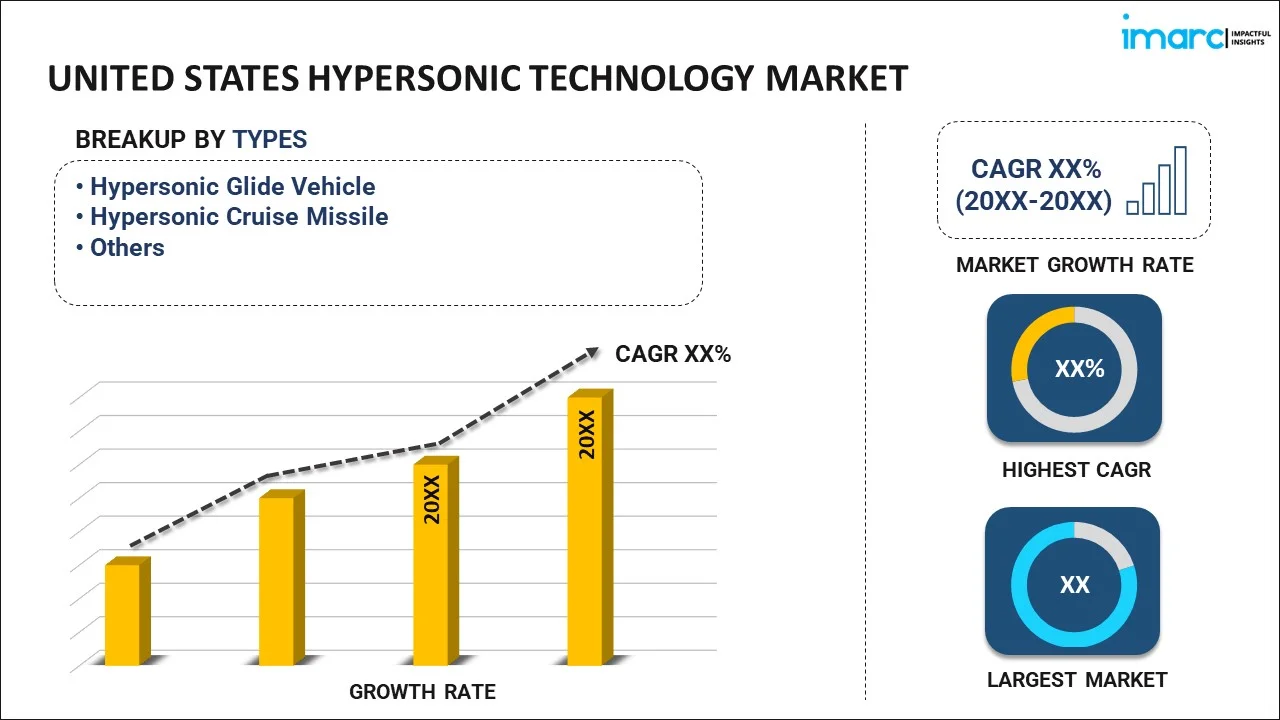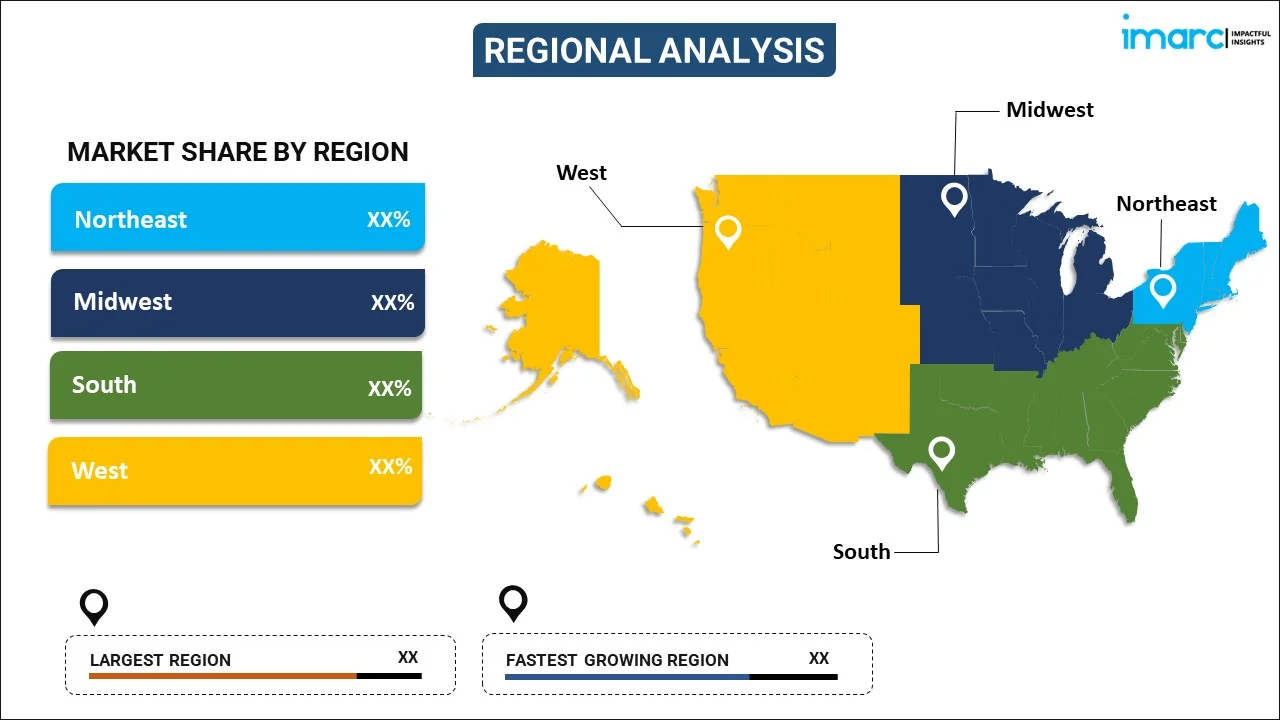
United States Hypersonic Technology Market Report by Type (Hypersonic Glide Vehicle, Hypersonic Cruise Missile, and Others), Launch Mode (Air Launched, Surface Launched, Subsea Launched), Range (Short Range, Medium Range, Intermediate Range, Intercontinental Range), End User (Military, Air Force, Navy, Space), and Region 2025-2033
United States Hypersonic Technology Market Overview:
The United States hypersonic technology market size reached USD 1.5 Billion in 2024. Looking forward, IMARC Group expects the market to reach USD 2.8 Billion by 2033, exhibiting a growth rate (CAGR) of 7.1% during 2025-2033. The growing demand to reduce intercontinental travel times and enhance the travel experiences of passengers, advancements in hypersonic missile systems to enable enhanced precision and evasive maneuvers, and rising development of materials that withstand extreme temperatures represent some of the key factors driving the United States hypersonic technology market share.
|
Report Attribute
|
Key Statistics
|
|---|---|
|
Base Year
|
2024 |
|
Forecast Years
|
2025-2033
|
|
Historical Years
|
2019-2024
|
| Market Size in 2024 | USD 1.5 Billion |
| Market Forecast in 2033 | USD 2.8 Billion |
| Market Growth Rate (2025-2033) | 7.1% |
United States Hypersonic Technology Market Analysis:
- Major Drivers: Government defense emphasis and strategic rivalry lead to demand. Technological breakthroughs in propulsion, materials, and aerospace systems enable innovation. Military desire for faster, more difficult-to-intercept weapons stimulates research and development initiatives.
- Key Market Trends: New private firms are driving innovation in hypersonics. Growing interoperability between defense organizations and tech startups. Reusable platforms and sophisticated simulations are becoming the hub of testing and design strategy.
- Market Opportunities: Possible expansion in defense use and commercial space. Creation of faster, more efficient transportation systems. Broadening research in material, propulsion, and navigation opens room for new solutions and collaborations.
- Market Challenges: Technical challenges in maintaining stability and resisting heat is a key challenge in the United States hypersonic technology market analysis. High cost of development and long lead times hamper scalability. Regulatory issues, shortage of infrastructure, and supply chain limitations impede implementation and testing.
Hypersonic technology is a technology in aerospace engineering that focuses on vehicles and systems that can achieve speed significantly faster than the speed of sound. It involves navigating through the atmosphere of Earth at extreme speeds while managing factors such as heat, pressure, and aerodynamics. It relies on advanced aerodynamics and propulsion systems to navigate through the atmosphere at increased velocities. It can potentially reduce travel times across continents and provide optimal accuracy, maneuverability, responsiveness, and strength in defense operations. It offers more efficient and cost-effective means of reaching space, conducting experiments, and studying phenomena in the upper atmosphere. It assists in enabling rapid and efficient movement of goods from one place to another. Besides this, it can rapidly change trajectory and maneuver at high speeds, which aids in enhancing reconnaissance, surveillance, and interception capabilities while providing enhanced security. As it is widely employed in air-breathing propulsion systems, scramjet missiles, and manned and unmanned weapon systems, the demand for hypersonic technology is rising in the United States.
United States Hypersonic Technology Market Trends:
Defense Modernization & Strategic Superiority
The key to new U.S. defense strategy is hypersonic technology, with its unparalled speed, range, and accuracy. As global threats are transforming, the necessity to develop quick-response weapons capable of evading conventional missile defense systems is growing. Military planners gain a profound ability to strike at high-value targets with smaller warning times using hypersonic systems, making enemy defense more difficult. These weapons are being created across air, land, and sea domains, forming a variable deterrent against regional and peer competitors. Aside from military competitive edge, leadership in hypersonic capabilities is considered one gauge of international technological position. The emphasis of the defense industry on innovation, along with national priority, is inspiring extensive research, prototyping, and system integration. These modernization initiatives are assisting in molding a new age in aerospace and military readiness.
Private-Sector Innovation & Reusable Testbeds
Private industry is playing an important role in driving hypersonic developments. In contrast to conventional government-sponsored programs, startups and aerospace companies are offering more adaptable, reusable platforms that facilitate regular testing and rapid turnaround. These companies push innovative propulsion architectures, material science, and flying systems more aggressively since they often have a higher risk tolerance. Their inventions are increasing cost-effectiveness in addition to accelerating research and development. Specifically, their emphasis on reusability and autonomous flight data acquisition is assisting in the simplification of the development cycle. The cooperation between private industry and defense agencies is becoming more profound with the government increasingly relying on these nimble players for speedy solutions. Through this partnership, innovation is accelerating and a more dynamic, competitive platform for hypersonic advancement is being created.
Domestic Manufacturing & Supply Chain Resilience
Strong domestic production capacity is critical to the establishment of a reliable hypersonic technology base. In order to maintain continuous development and deployment, steps are being taken to fortify the entire supply chain—ranging from advanced propulsion components to high-temperature materials. Advanced manufacturing practices such as 3D printing are being used by companies to accelerate production while improving quality and accuracy. These steps decrease dependency on overseas suppliers and increase resilience against geostrategic disruptions. Investment in homegrown talent and infrastructure is also increasing the country's ability to sustain long-term innovation in this area. By producing and innovating at home, the U.S. can more easily ramp up hypersonic systems rapidly when required. This increasing emphasis on supply chain sovereignty provides for continuity, responsiveness, and national security in a fast-evolving technological environment.
United States Hypersonic Technology Market Segmentation:
IMARC Group provides an analysis of the key trends in each segment of the United States hypersonic technology market report, along with forecasts at the country level for 2025-2033. Our report has categorized the market based on type, launch mode, range, and end user.
Type Insights:

To get more information on this market, Request Sample
- Hypersonic Glide Vehicle
- Hypersonic Cruise Missile
- Others
The report has provided a detailed breakup and analysis of the market based on the type. This includes hypersonic glide vehicle, hypersonic cruise missile, and others.
Launch Mode Insights:
- Air Launched
- Surface Launched
- Subsea Launched
A detailed breakup and analysis of the market based on the launch mode has also been provided in the report. This includes air launched, surface launched, and subsea launched.
Range Insights:
- Short Range
- Medium Range
- Intermediate Range
- Intercontinental Range
A detailed breakup and analysis of the market based on the range has also been provided in the report. This includes short range, medium range, intermediate range, and intercontinental range.
End User Insights:
- Military
- Air Force
- Navy
- Space
A detailed breakup and analysis of the market based on the end user has also been provided in the report. This includes military, air force, navy, and space.
Regional Insights:

- Northeast
- Midwest
- South
- West
The report has also provided a comprehensive analysis of all the major regional markets, which include Northeast, Midwest, South, and West.
Competitive Landscape:
The report has also provided a comprehensive analysis of the competitive landscape in the market. Competitive analysis such as market structure, key player positioning, top winning strategies, competitive dashboard, and company evaluation quadrant has been covered in the report. Also, detailed profiles of all major companies have been provided.
United States Hypersonic Technology Market Report Coverage:
| Report Features | Details |
|---|---|
| Base Year of the Analysis | 2024 |
| Historical Period | 2019-2024 |
| Forecast Period | 2025-2033 |
| Units | Billion USD |
| Scope of the Report | Exploration of Historical and Forecast Trends, Industry Catalysts and Challenges, Segment-Wise Historical and Predictive Market Assessment:
|
| Types Covered | Hypersonic Glide Vehicle, Hypersonic Cruise Missile, Others |
| Launch Modes Covered | Air Launched, Surface Launched, Subsea Launched |
| Ranges Covered | Short Range, Medium Range, Intermediate Range, Intercontinental Range |
| End Users Covered | Military, Air Force, Navy, Space |
| Regions Covered | Northeast, Midwest, South, West |
| Customization Scope | 10% Free Customization |
| Post-Sale Analyst Support | 10-12 Weeks |
| Delivery Format | PDF and Excel through Email (We can also provide the editable version of the report in PPT/Word format on special request) |
Key Benefits for Stakeholders:
- IMARC’s report offers a comprehensive quantitative analysis of various market segments, historical and current market trends, market forecasts, and dynamics of the United States hypersonic technology market from 2019-2033.
- The research study provides the latest information on the market drivers, challenges, and opportunities in the United States hypersonic technology market.
- Porter's five forces analysis assist stakeholders in assessing the impact of new entrants, competitive rivalry, supplier power, buyer power, and the threat of substitution. It helps stakeholders to analyze the level of competition within the United States hypersonic technology industry and its attractiveness.
- Competitive landscape allows stakeholders to understand their competitive environment and provides an insight into the current positions of key players in the market.
Key Questions Answered in This Report
The United States hypersonic technology market was valued at USD 1.5 Billion in 2024.
The United States hypersonic technology market is projected to exhibit a CAGR of 7.1% during 2025-2033, reaching a value of USD 2.8 Billion by 2033.
Key factors driving the United States hypersonic technology market include defense modernization needs, strategic competition with global powers, and rapid advancements in propulsion and materials science. Increased collaboration between government and private industry also accelerates innovation, while the push for supply chain resilience and reusable systems supports sustainable development and deployment.
Need more help?
- Speak to our experienced analysts for insights on the current market scenarios.
- Include additional segments and countries to customize the report as per your requirement.
- Gain an unparalleled competitive advantage in your domain by understanding how to utilize the report and positively impacting your operations and revenue.
- For further assistance, please connect with our analysts.
 Request Customization
Request Customization
 Speak to an Analyst
Speak to an Analyst
 Request Brochure
Request Brochure
 Inquire Before Buying
Inquire Before Buying




.webp)




.webp)












